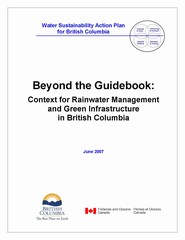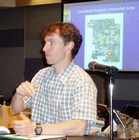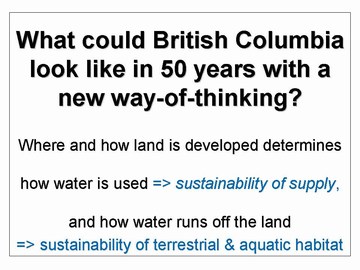Washington State conference showcases British Columbia approach to rainwater management
Conference Theme: Transboundary water resources of Washington State and British Columbia
The American Water Resources Association and the Canadian Water Resources Association co-hosted a conference in Seattle, Washington on  October 4-5, 2007. The conference was structured as six sessions, with four on Day One and two on Day Two. The format for each session was three presentations followed by a panel discussion. The sessions were titled:
October 4-5, 2007. The conference was structured as six sessions, with four on Day One and two on Day Two. The format for each session was three presentations followed by a panel discussion. The sessions were titled:
- Stormwater Management and Low Impact Development
- Liquid Waste Management: Going with the Flow?
- Climate Change: Can we effectively analyze, design and build water resource projects?
- Case Studies I (will build on Session 3)
- Managing the Columbia River for the Mutual Benefit of the US and Canada
- Case Studies II
For an overview of each session, please click on this link to Transboundary Water Resources of Washington State and British Columbia.
Stormwater Management and Low Impact Development
The Puget Sound is the second largest estuary in the United States and Canada. Water quality problems and the steady decline in aquatic and marine species, particularly salmon, in the sound continue to affect the quality of life and valued ecosystem components. The Region implemented some of the earliest stormwater quality treatment requirements.
What effects have technology improvements and increasingly stringent rainwater/ stormwater management requirements over the past 20 years had on the water quality of receiving waters?
How will those resources be affected by burgeoning population growth and development in the future?
And what lessons can Washington State and British Columbia learn from each other as they strive to minimize the impacts of rainwater/stormwater runoff?
In this session Kim Stephens P.Eng., Program Coordinator, Water Sustainability Action Plan for British Columbia, Gary Minton, PhD, Resource Planning Associates, and Ed O’Brien, Ecology Water Quality Program were invited to discuss and contrast approaches to rainwater/stormwater management taken on both sides of the border.
To Learn More:
For the complete story, click on this link to Rainwater Management on Diverging Paths in British Columbia and Washington State?
Rainwater Management and Green Infrastructure in British Columbia
 The session on Stormwater Management and Low Impact Development featured a presentation about Beyond the Guidebook: Context for Rainwater Management and Green Infrastructure in British Columbia.This was actually be a co-presentation by Kim Stephens and Remi Dube (Drainage Planning Manager, City of Surrey).
The session on Stormwater Management and Low Impact Development featured a presentation about Beyond the Guidebook: Context for Rainwater Management and Green Infrastructure in British Columbia.This was actually be a co-presentation by Kim Stephens and Remi Dube (Drainage Planning Manager, City of Surrey).
“The approach that is being advanced in British Columbia builds on lessons that we learned from Washington State a decade ago, yet is moving in a different direction”, comments Kim Stephens, “We have gone back to the fundamentals of how we develop land, and are keying our efforts to the fact that  water volume is something over which local government has control through its infrastructure policies, practices and standards.”
water volume is something over which local government has control through its infrastructure policies, practices and standards.”
The title of the co- presentation by Stephens and Dube was Beyond the Guidebook: Designing with Nature to Create Liveable Communities and Protect Stream Health.
From Stormwater Management
to Rainwater Management
In 2002, when Stormwater Planning: A Guidebook for British Columbia was published, its underlying premise that land development and watershed protection can be compatible represented a radical shift in thinking. The Guidebook established the framework for rainfall capture and a performance target way-of-thinking and designing.
Through implementation of ‘green infrastructure’ policies and practices, the desired outcome in going Beyond the Guidebook is to apply what has been learned at the site scale over the past five years…so that stream health in urban watersheds can be truly protected and/or restored.
According to Remi Dube, “Beyond the Guidebook is an inter-governmental initiative that builds on the Guidebook foundation by advancing a runoff-based approach and tool to help local governments achieve desired urban stream health and environmental protection outcomes at a watershed scale.”
The pilot for Beyond the Guidebook is the City of Surrey’s Fergus Creek Watershed Plan. The plan is precedent-setting because there will be no large-scale storage ponds. “Rather, rainwater runoff volume will be managed through constructed facilities and the creation of contiguous large-scale greenways that have been integrated into the area’s land use plan”, adds Remi Dube.

Conference Overview
The conference featured a host of invited speakers from both Washington and British Columbia who provided assessments of water-related research, management and policy in both jurisdictions.
The conference explored approaches to managing stormwater/ rainwater and liquid waste, adjusting to the reality of climate change and addressing important transboundary topics of interest like those in the Columbia River Basin. There was also a political context from key decision-makers and substantial opportunity for dialogue through our interactive panel sessions.
The target audience for the conference comprised of scientists, managers, engineers and policy-makers in Washington and British Columbia. The conference proved to be informative, relevant and well-attended by professionals in the water resource industry throughout Washington and British Columbia.
Posted August 2007
Updated August 2008


